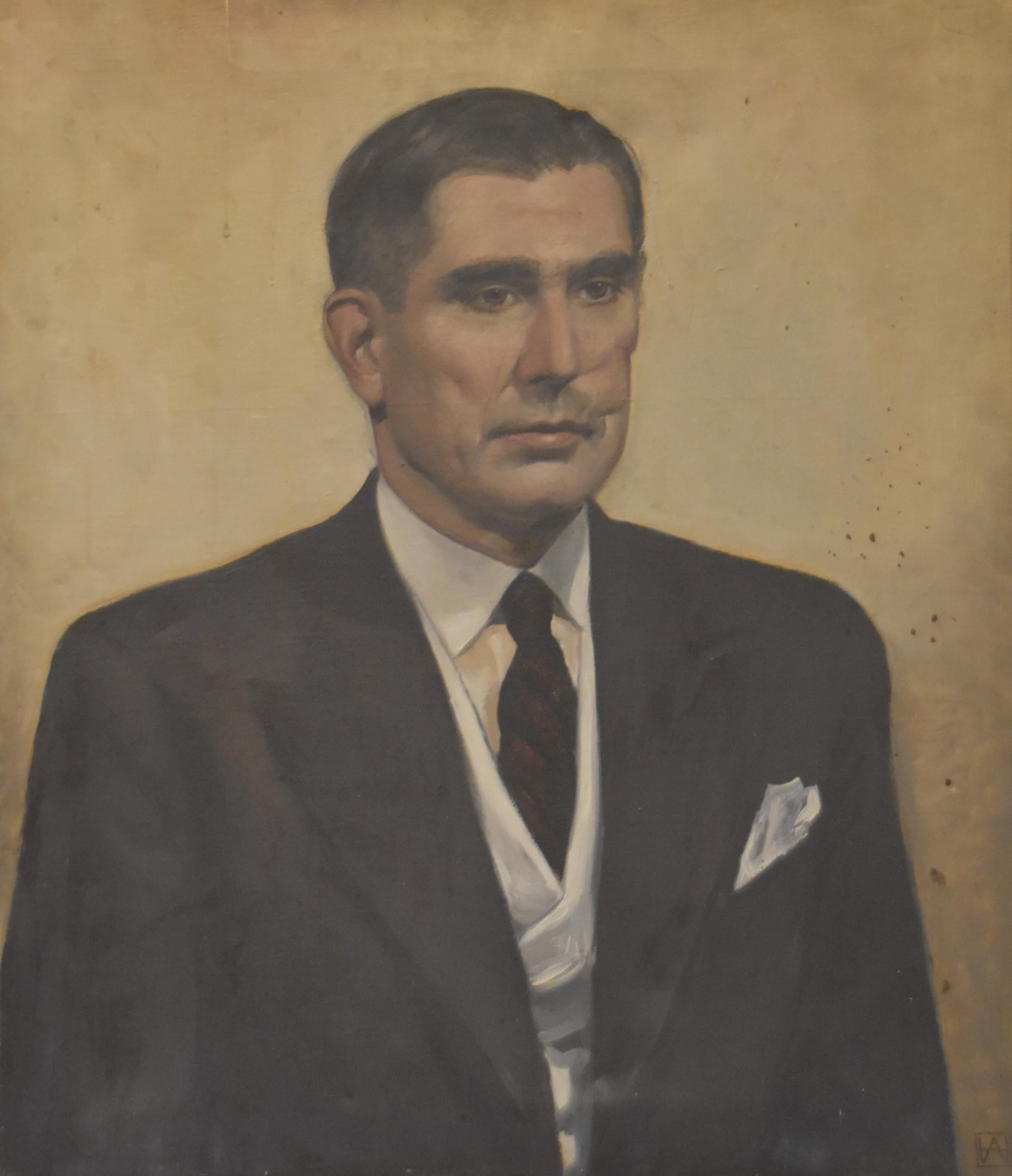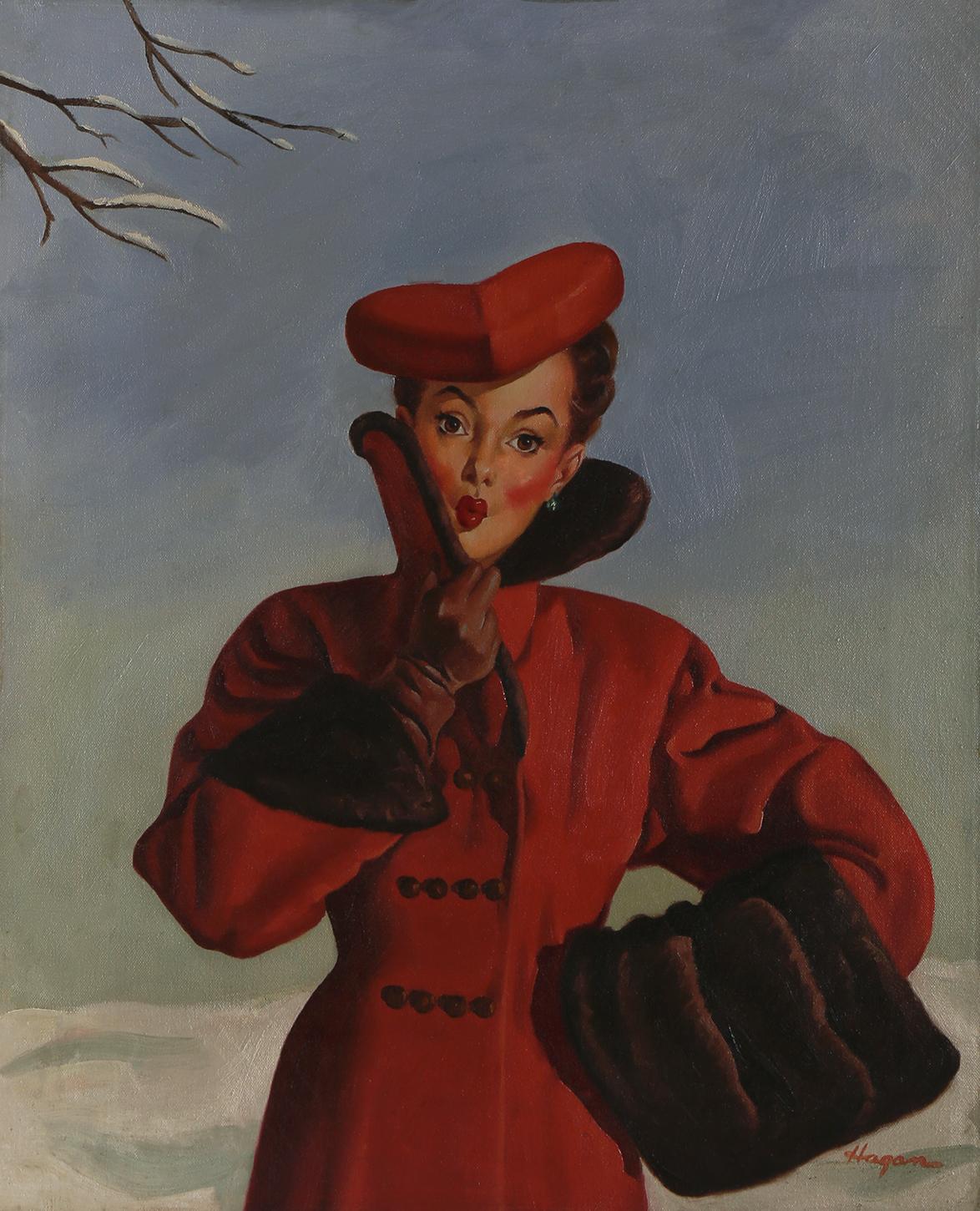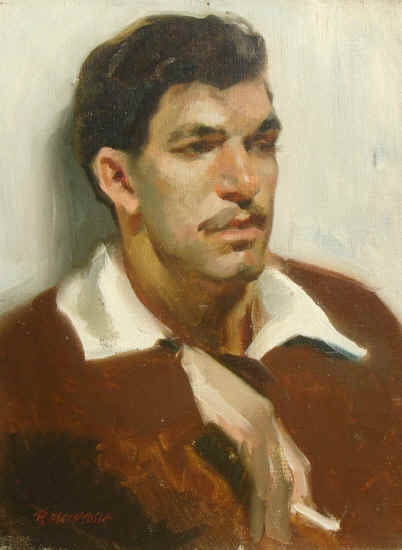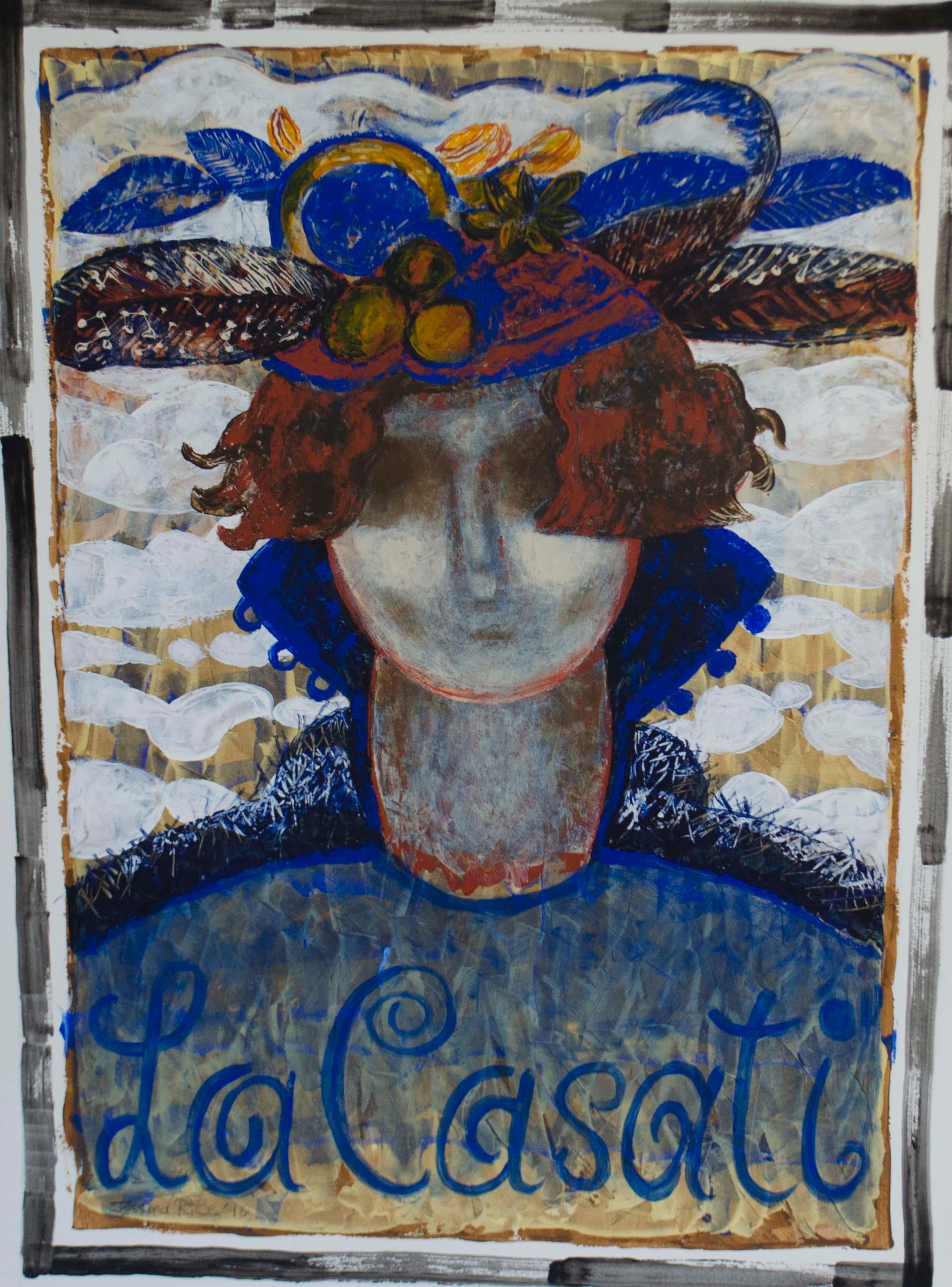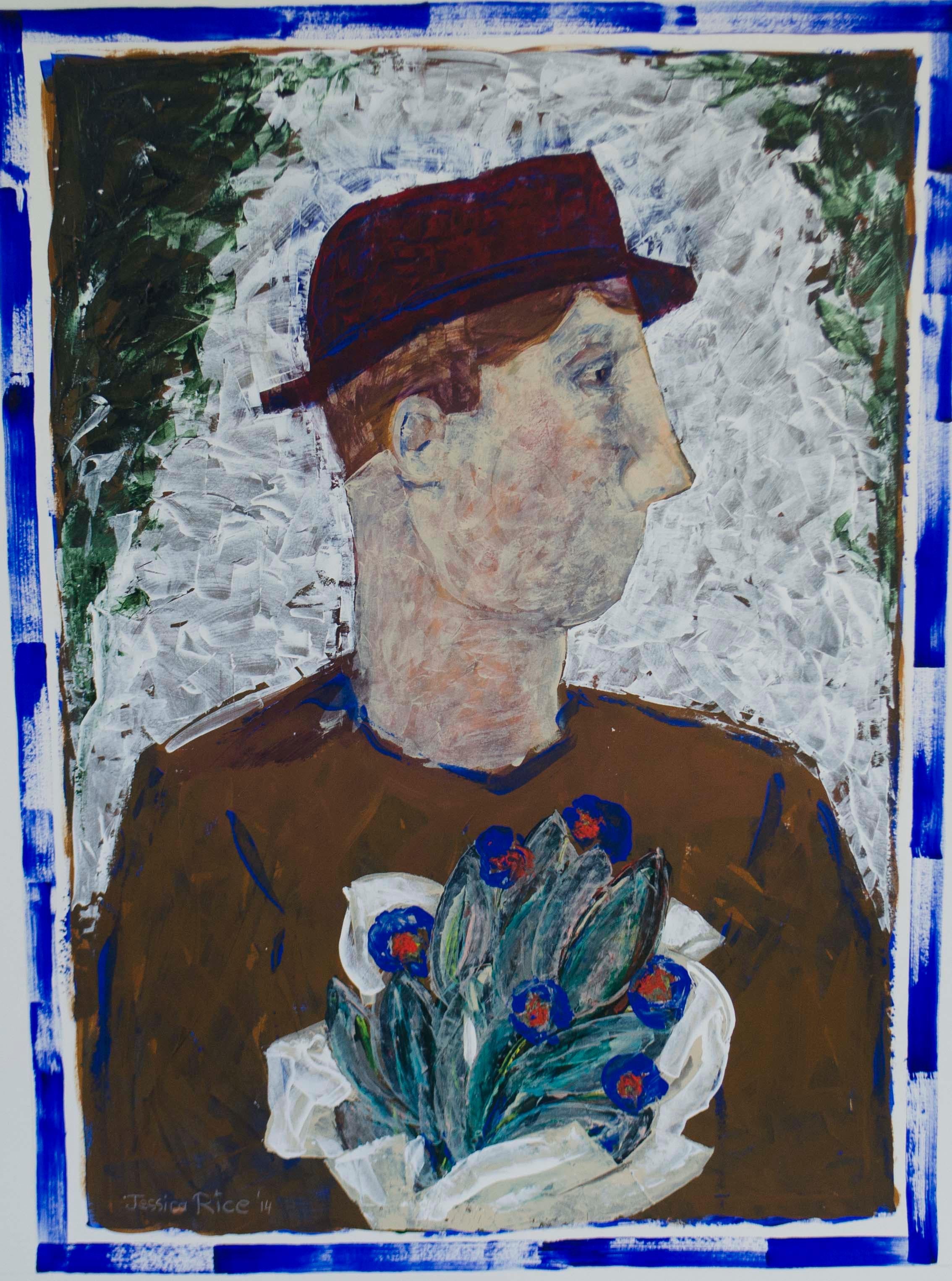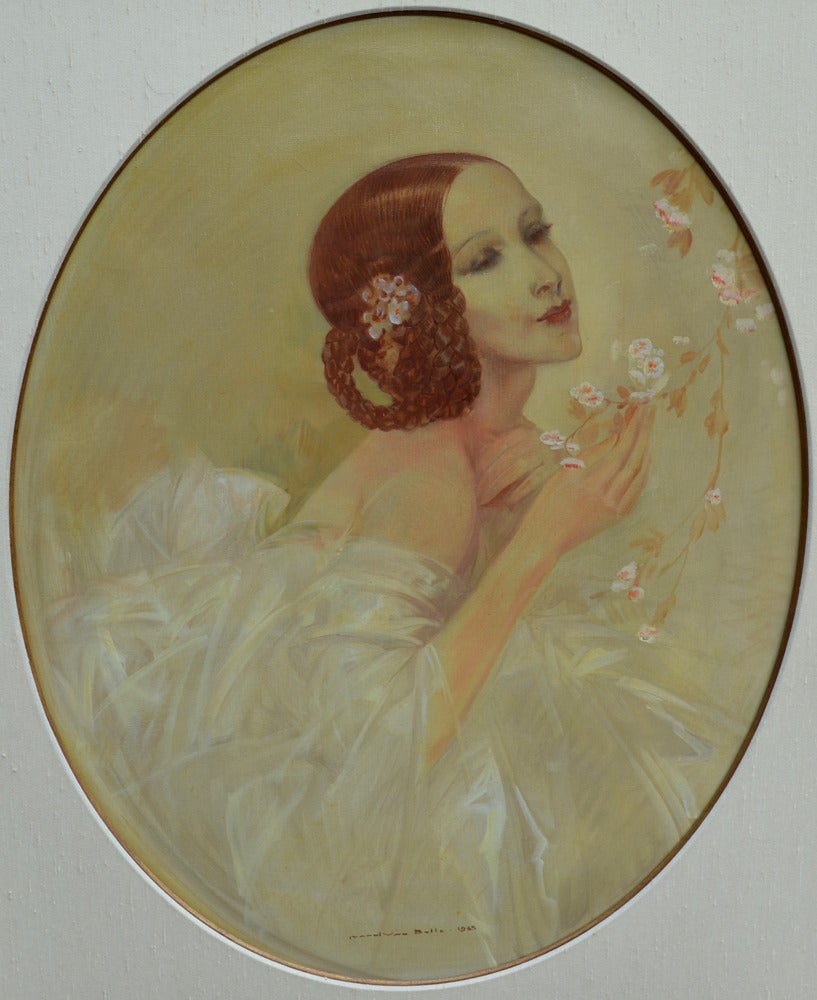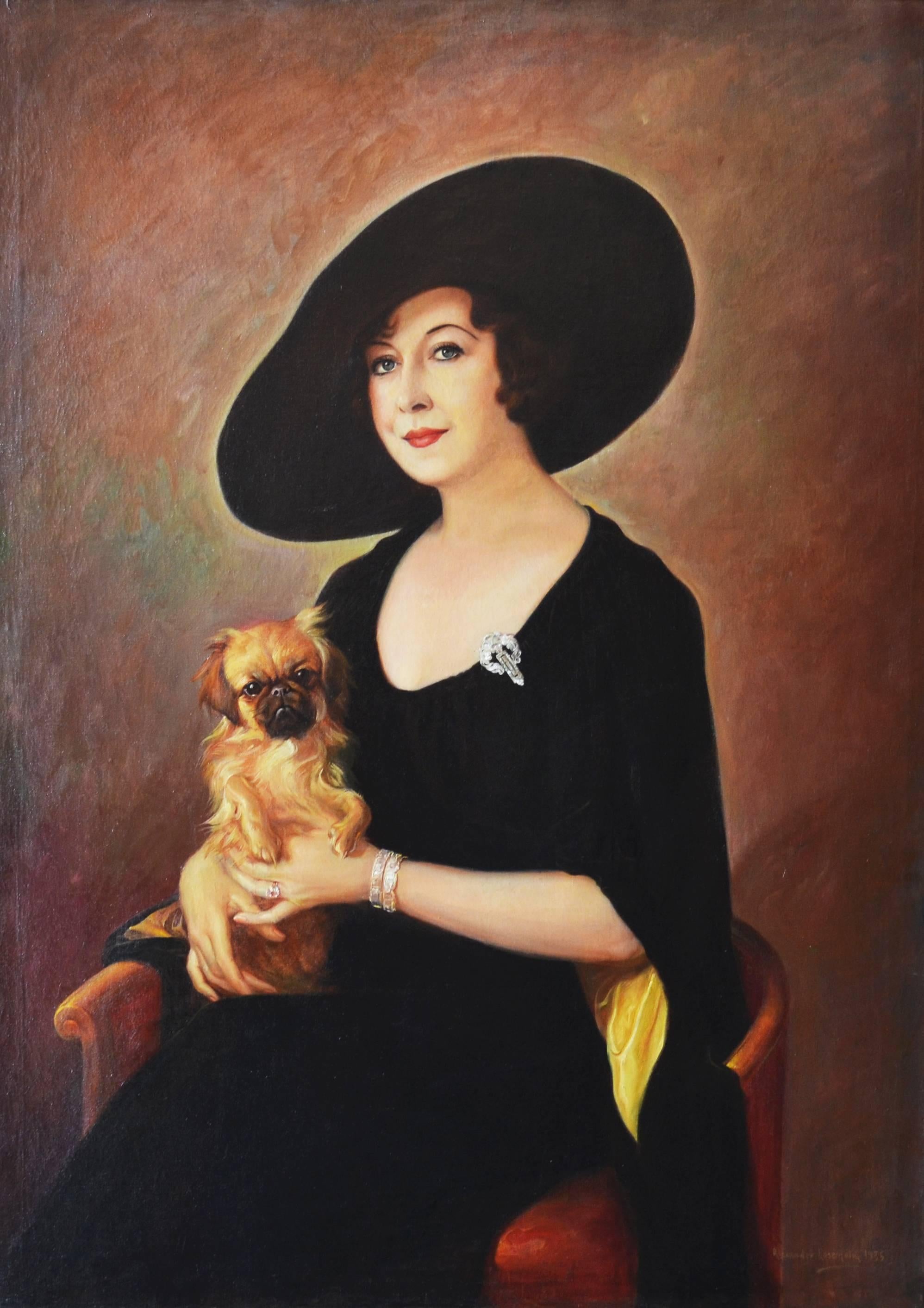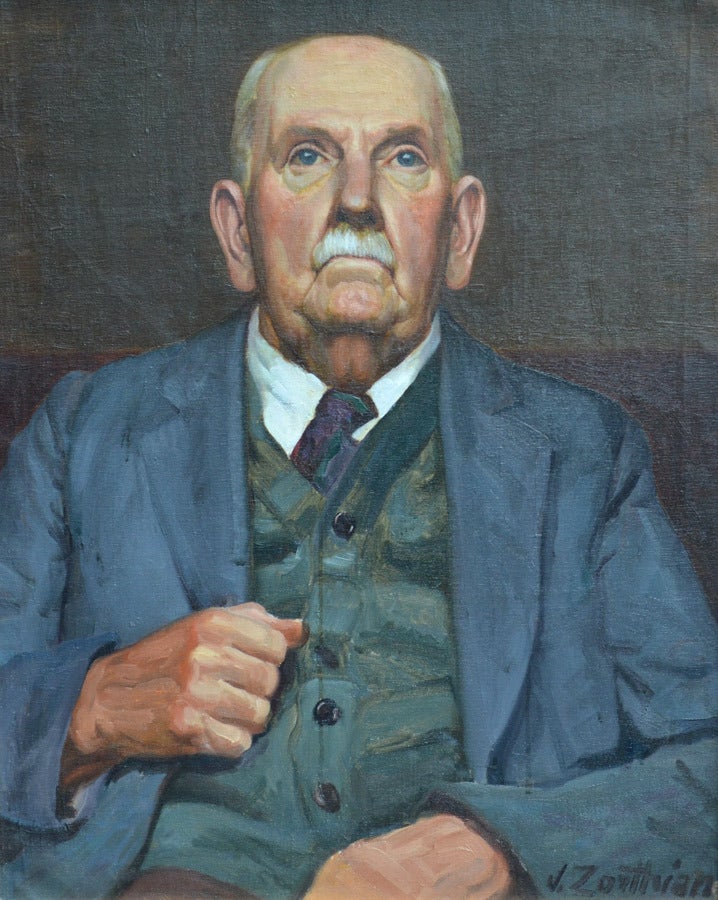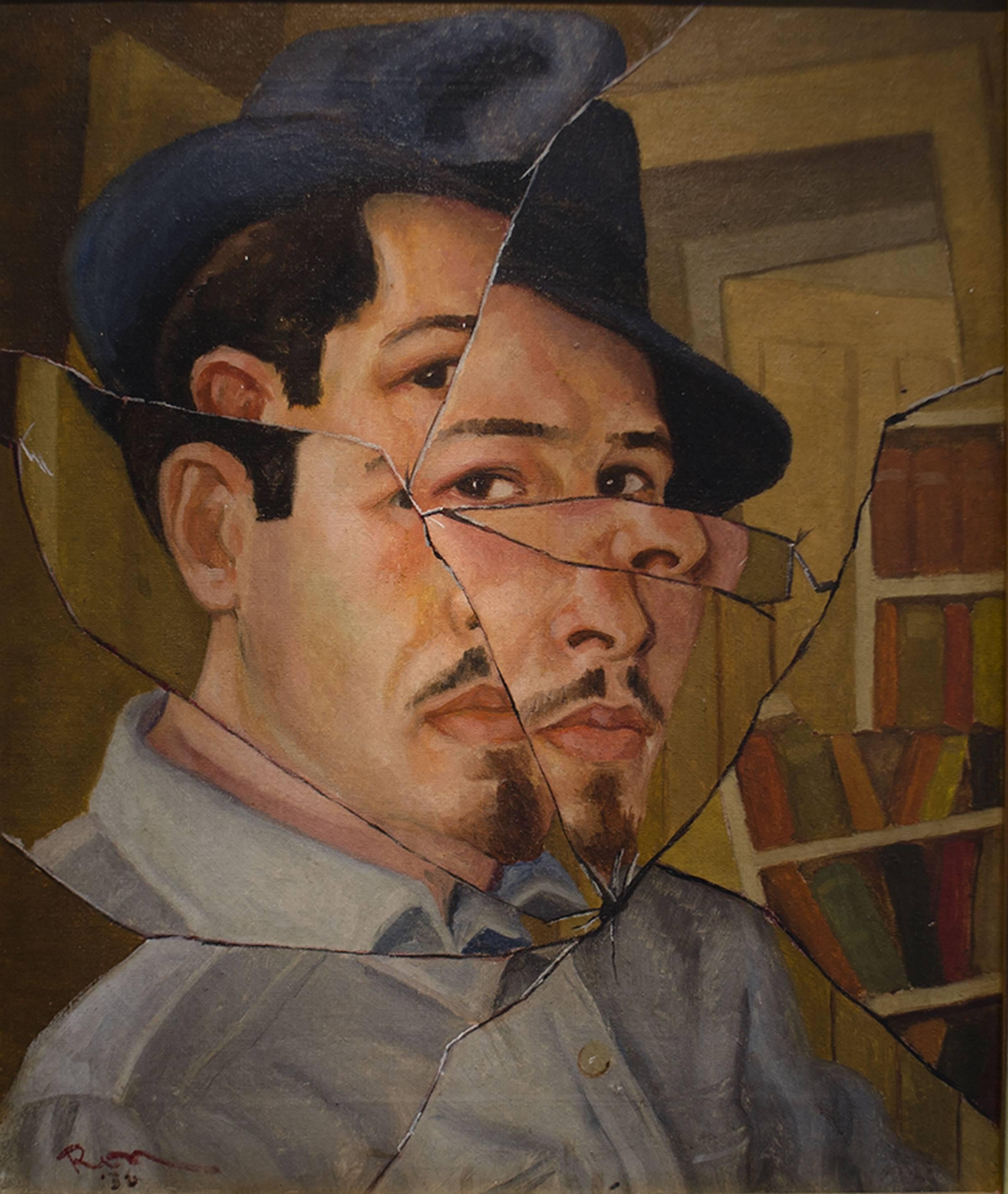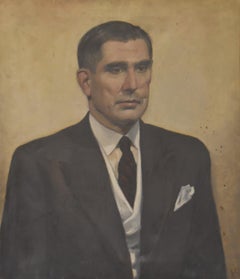
Portrait of a Woman
View Similar Items
Want more images or videos?
Request additional images or videos from the seller
1 of 3
Carl RunnströmPortrait of a Woman1925
1925
About the Item
- Creator:Carl Runnström (1891 - 1980, Swedish)
- Creation Year:1925
- Medium:
- Movement & Style:
- Period:
- Condition:
- Gallery Location:Los Angeles, CA
- Reference Number:1stDibs: LU39717582
About the Seller
5.0
Vetted Seller
These experienced sellers undergo a comprehensive evaluation by our team of in-house experts.
Established in 1972
1stDibs seller since 2011
More From This SellerView All
- RelaxingBy Richard GeigerLocated in Los Angeles, CARICHARD GEIGER "RELAXING" OIL ON CANVAS, SIGNED HUNGARIAN, C.1930 28 X 39 INCHES FRAMED 36.5 X 46 INCHES Richard Geiger 1870-1945 Richard Geiger was born in Vienna and first studied at the Vienna Art Institute with the academic painter Christian Ludwig Von Griepenkerl and, subsequently, in Paris with Francois Flameng...Category
1930s Art Deco Portrait Paintings
MaterialsCanvas, Oil
$1,625 Sale Price50% Off - Lady in the Paris ParkLocated in Los Angeles, CABeautiful young lady in a Paris Park, signed, Original Frame, listed size includes the frame.Category
1950s Impressionist Figurative Paintings
MaterialsPanel, Oil
$788 Sale Price49% Off - The PatriarchBy Anna WalinskaLocated in Los Angeles, CAANNA WALENSKA "THE PATRIARCH" OIL ON PANEL, SIGNED ON VERSO AMERICAN, DATED 1950-51 29.5 X 25.5 INCHES FRAMED 38.75 X 33.75 INCHES ANNA WALINSKA 1906 – 1997 A painter, illustrator and teacher at the Master Institute of Arts in New York City, Anna Walinska was born in London, England and settled in New York in 1914. Showing obvious art talent as a youngster, she first enrolled in the Art Students League in 1918 when she was age 12. Walinska lived on and off in Paris from 1928-1930, and studied there with Andre Lhote. She founded the Guild Art Gallery on West 57th Street in 1935, where she gave Arshile Gorky his first New York one-man show. In 1939, she served as the Assistant Creative Director of the Contemporary Art Pavilion at the New York World's Fair in 1939. She traveled around the world in 1955, including a four month sojourn in Burma, and she taught at the Riverside Museum from 1957-1971. Major exhibitions included: solo retrospective at the Jewish Museum, 1957; solo retrospective at the Museum of Religious Art, Cathedral of St. John the Divine, 1979; posthumous solo exhibition at the Ghetto Museum, Theresienstadt, Czech Republic, 2000. Group exhibitions included: Salon des Independents, Paris, c. 1926-30; first annual exhibition of the American Artists' Congress in 1937; Artists for Victory, Metropolitan Museum of Art, 1942; Paintings of the Year, National Academy of Design, 1946; Recent Drawings USA, MOMA, 1956; Baltimore Museum of Art, 1957; numerous exhbit ions with the National Association of Women Artists and the Federation of Modern Painters & Sculptors. Walinska's are included in numerous museum collections both here and abroad, including: The National Portrait Gallery, National Museum of American Art, National Museum of Women in the Arts, Rose Art Museum at Brandeis University, Herbert Johnson Museum at Cornell University, Judah L. Magnes Museum, Jewish Museum, Jane Voorhees Zimmerli Museum at Rutgers, United States Holocaust Memorial Museum, Tel Aviv Museum of Art, and Yad Vashem. Walinska's scrapbooks of the Guild Art Gallery (see below), along with sketchbooks and journals on world travel are included in the Archives of American Art at the Smithsonian. ---------------------------------------------------------------------- MUSEUM PERMANENT COLLECTIONS: Asia Society, NYC Portrait of U Nu, 1955: oil on canvas, 41 x 50 Center for Holocaust & Genocide Studies, Clark University, Worcester Massachusetts Victims, 1956, oil on paper, 30-3/4 x 24-1/2 Victims, 1959, oil on paper mounted on masonite, 72 x 36 Victims in Madhouse, oil & chalk on paper, 42-1/2 x 30-1/2 Elegy, 1978, charcoal & oil on masonite board, 25-1/2 x 38 Herbert Johnson Museum, Cornell University, Ithaca NY Portrait of Arshile Gorky, 1975, oil on canvas, 61 x 35-1/2 Survivors: Exile in Landscape, 1957, oil on paper, 26 x 38-1/4 Victim: Buddha Figure, 1956, ink on paper, 58 x 34 Hyde Park Library, Long Island NY Portrait of Eleanor Roosevelt, charcoal on canvas, 23-1/2 x 25-1/2 Jewish Museum, NYC Moses, 1962: charcoal on heavy paper, 23 x 43 Judah L. Magnes Museum, Berkeley CA Victims: Ghetto Figures in Landscape, 1957, oil on canvas, 20 x 24 (Holocaust series #24) Victims: Figures in Ghetto, 1957, oil on canvas board, 20 x 16 (Holocaust series #25) Victims: Women & Girls on Way to Gas Chamber, 1978, charcoal on paper, 42-1/2 x 30-1/2 (Holocaust series #44) Survivors: Figures Behind Barbed Wire, 1973, oil on paper, 42-12/ x 30-1/2 (Holocaust series#46) Portrait of Mark Rothko, ink on paper, 42 x 30 Portrait of Louise Nevelson, 1978, ink on paper, 42 x 30 Portrait of Moshe...Category
1850s Cubist Figurative Paintings
MaterialsOil, Panel
Sold$6,375 - Home FireBy Yuri Martinez RamosLocated in Los Angeles, CAYURI MARTINEZ RAMOS "HOME FIRE OIL ON CANVAS, SIGNED CUBAN-AMERICAN, C.2006 20 X 16 INCHES Home Fire" brings me back to my childhood home when my grandpa visited us every day smoking his pipe and conversing good moments. Yuri Martinez Ramos was born in Havana, Cuba on November 24, 1964. He studied at the Elemental School of Plastic Arts from 1975 – 1979 and the National School of the Arts from 1979 – 1983. Martinez’ figurative paintings have been compared to Botero because of his satirical social commentary. His style, however, is uniquely his own with typically vibrant Latin colors and use of expressive magical realism. His paintings tell his story and the story of the Cuban dilemma. Martinez was granted permission by the US Justice Department after much effort with Cuban authorities to come to the US with his family and pursue his career outside Cuba. He now lives and works in Texas. Papillon Gallery...Category
Early 2000s Surrealist Figurative Paintings
MaterialsCanvas, Oil
$1,688 Sale Price24% Off - BLONDE WITH ART DECO NECKLACELocated in Los Angeles, CABiography from the niece of the artist from during his lifetime. Paintings acquired from the artist.s estate. Max Turner 1925 - 2019 Max Lamar Turner Painter, Sculptor, Teacher and Author. Max Turner was born in Omaha, Nebraska on July 28, 1925. His father was Lance Howard Turner and his mother Mary Irene Turner. In 1927, his family moved to Bingham Canyon, Utah where Max's father extracted copper from a creek that he had diverted to pass through his garage. The town was located in a narrow canyon on the eastern face of the Oquirrh Mountains. In 1938, when Max was 13, his family moved to Midvale, Utah. After completing high school, Max went to work laying rail until he was inducted into the U.S. Navy to serve during W.W. II. There he took an aptitude test and was initially assigned to the medical corp., later transferring to the dental unit. Max was stationed at Port Hueneme, Ventura County, California through the end of the war. When he was discharged in 1946, he remained in Southern California, living in the Los Angeles area. He met a man named Larry Torres and they formed a partnership to do silk screen work primarily for the Colby Poster Printing Company. This lasted about 10 years until the Colby building caught fire and burned down. In 1958, Max began working for Slade Novelty company that made doll parts using a product called plastisol. A year later, Max began producing plastic parts through his own business. One day, a couple of kids brought in a shrunken skull they had made and asked Max if he could reproduce it. Max said he could and he looked around for a business to work with for this task. He ultimately decided he could create his own machine shop to make molds. As a result, Max purchased a lathe, drill press, grinder and other tools to create his own machine shop and went into business making molds. He built a clientele and in 1973, he moved his machine shop to Glendale, California. Painter, Sculptor, Teacher and Author: Max recalls the day when his interest in art took a new direction. He happened to be in a paint store to purchase some supplies when he saw a card posted on a wall that read, "Come paint with Connie Marlo". Max had been interested in art since his youth and he was frequently impressed with paintings displayed by local artists at various community events. Consequently, he decided to go to Connie's Saturday morning art class at a studio on North La Brea Avenue (between Sunset and Hollywood) in Los Angeles. But, as fate would have it, he immediately took a detour from this class when he found a piece of paper on the floor of the studio referencing another art class dealing with compositions, patterns, rhythms and color harmony. The instructor's name was Hal Reed, a former art student of the Russian/American Master, Nicolai Fechin. Hal owned the building (previously the Will Foster Studio) and had founded the Art League of Los Angeles. When Max found Hal, he asked Hal if he could join his class. Hal said "No, the class was full" but he said Max could monitor the class in the back of the classroom. Max took him up on the offer and began observing the weekly class. During the class, Hal told his students that they should practice what they were learning by going to "live model" classes. Max began attending these classes where he learned how to draw figures. After a few months, Hal and Max became good friends. Hal was so impressed with Max's work that he offered Max the opportunity to teach at another location that Hal was opening in the San Fernando Valley. Max accepted the offer and began teaching his own art class. For Max, it was a quick jump from learning to teaching. Max then found that several of his students had to commute to his art class from the west end of the "Valley". To better serve this group of students, Max decided to relocate to another studio in Calabasas. Max continued teaching, and at this time he was producing very impressive portraits, both oil paintings and charcoal drawings from live models (Max never worked from photos). Max demonstrated real talent, and the style of his drawings and paintings were being compared to those of Nicolai Fechin. And, like Fechin, Max also had an interest in sculpting. One day, Max decided to design and cast a bronze owl sculpture to put in his Calabasas Fine Art Gallery. Later, someone approached Max when he was at the foundry and asked him about his success selling the owl sculpture. The individual who asked this question was convinced that there was a broader market for these sculptures and he ordered a dozen of the owl sculptures from Max. This encouraged Max to do more castings. Some of the new castings were antique sculptures he found and reproduced. As this new business grew, he decided to establish his own foundry, employing up to 15 workers. The business continued for many years, up until the late 1990's when Max got tired of the foundry business and sold it. Max, who was now in his 70's, decided to move on to his next venture as an artist, dedicating himself to doing the actual sculpting of original art. He loved the creativity of sculpting and he had his sculptures cast at local foundries, ironically the same ones that used to be his competition. Max was now fully engaged in his new artistic direction and, over time, he produced a large body of work. He created very impressive sculptures, including about 100 full-size sculptures. He sold some of these to high-end clientele, the Foundry at SLS Las Vegas, and to Hollywood studios. Even though Max now seemed to be totally in his element, he somehow also found time to continue to teach painting classes at the California Art Institute in Westlake Village in Los Angeles. At the institute, he specialized in figure work. Max continued to draw, paint and teach, but he says he stopped sculpting when he turned 90. Max produced four books showcasing his drawings and paintings. The first is "Faces, The Drawings of Max Turner", copyright 2000, that showcases nearly 100 of his portrait drawings. Within the "Acknowledgements" section, he lists Hal Reed and Joseph Nordmann, two former students of Nicolai Fechin. In 2006, Max produced his second book titled "Figures and Faces", reflecting not only portraits but also figure drawings and paintings. It is a wonderful book of Max's work, but it is currently difficult to find. The third book is titled "Faces 2, The Paintings and Drawings of Max Turner", copyright 2009, which includes 75 portrait paintings and drawings. In the "Preface" of this book, Max describes growing up in a small and isolated mining town during the Great Depression. He states that as a kid, he had little exposure of any culture or view of what the rest of the world was like. His neighbor was the trash collector and Max would sometimes go through his truck looking for anything of value. Among other things, he found magazines like Cosmopolitan, Good Housekeeping and Red Book, with covers that frequently showed drawings or paintings of faces. Max states that these images were the very first source of inspiration for him. He says that he began looking more carefully at people's faces and if they had character, he would draw them. By drawing them, Max says that he was making them part of his world, his world of "Faces". In 2018, Max published his newest book showcasing his drawings and paintings. It is titled "Max Turner's Figure Sketches". This softbound book includes 76 pages and over 120 drawings and paintings. In the Introduction, Max explains "I have found that when approaching the figure, one should begin with the gesture. After having captured the essence or feeling of the pose, one can then proceed to build on it." The figure sketches in this wonderful book reflect a Master's work that consistently captures the "gesture"-showing the emotion, movement and expression. Two more books are on the horizon for Max, both dealing with his passion for sculpting. His first, "The Sculpture of Max Turner" is a compilation of his commercial and noncommercial pieces throughout his career. The second, "Terra Cotta Sculpture by Max Turner" is a complete collection of figures done at the California Art Institute. These much anticipated books should be out later in 2018. Max now considers himself primarily a sculptor. But others in the art world are more than impressed with his drawings and paintings as well. His portraits are often described as having a Fechin-esque appearance, referring to the style of Nicolai Fechin. When Max observed those first art classes given by Hal Reed, it should be noted that Hal had previously been a student of the Russian/American Master Nicolai Fechin in the early to mid-1950's. In fact, Hal was a student in the last art class that Fechin taught before he unexpectedly died in 1955. Hal was so strongly influenced by Fechin that he later produced two 30-minute art instruction videos as part his Art Video Productions wherein he specifically described Fechin techniques that he learned in Fechin's class. The Fechin style and techniques were in play when Max later met Hal. Over the years, many of Max's art students, art collectors, gallery owners, as well as the Director of the Monterey Museum of Art have commented on the Fechin-esque qualities of Max's wonderful charcoal drawings and paintings. So, while Max may consider himself primarily a sculptor, his drawings and paintings are also impressive and very much sought after. When Nicolai Fechin died in 1955, three of the nine students in his last art class became life-long friends. Max subsequently became friends with not only Hal Reed, but also with prior Fechin students Joseph Nordmann and Albert Londraville...Category
1990s Modern Figurative Paintings
MaterialsCanvas, Oil
$650 Sale Price48% Off - LADY WITH PICK FANLocated in Los Angeles, CABiography from the niece of the artist from during his lifetime. Paintings acquired from the artist.s estate. Max Turner 1925 - 2019 Max Lamar Turner Painter, Sculptor, Teacher and Author. Max Turner was born in Omaha, Nebraska on July 28, 1925. His father was Lance Howard Turner and his mother Mary Irene Turner. In 1927, his family moved to Bingham Canyon, Utah where Max's father extracted copper from a creek that he had diverted to pass through his garage. The town was located in a narrow canyon on the eastern face of the Oquirrh Mountains. In 1938, when Max was 13, his family moved to Midvale, Utah. After completing high school, Max went to work laying rail until he was inducted into the U.S. Navy to serve during W.W. II. There he took an aptitude test and was initially assigned to the medical corp., later transferring to the dental unit. Max was stationed at Port Hueneme, Ventura County, California through the end of the war. When he was discharged in 1946, he remained in Southern California, living in the Los Angeles area. He met a man named Larry Torres and they formed a partnership to do silk screen work primarily for the Colby Poster Printing Company. This lasted about 10 years until the Colby building caught fire and burned down. In 1958, Max began working for Slade Novelty company that made doll parts using a product called plastisol. A year later, Max began producing plastic parts through his own business. One day, a couple of kids brought in a shrunken skull they had made and asked Max if he could reproduce it. Max said he could and he looked around for a business to work with for this task. He ultimately decided he could create his own machine shop to make molds. As a result, Max purchased a lathe, drill press, grinder and other tools to create his own machine shop and went into business making molds. He built a clientele and in 1973, he moved his machine shop to Glendale, California. Painter, Sculptor, Teacher and Author: Max recalls the day when his interest in art took a new direction. He happened to be in a paint store to purchase some supplies when he saw a card posted on a wall that read, "Come paint with Connie Marlo". Max had been interested in art since his youth and he was frequently impressed with paintings displayed by local artists at various community events. Consequently, he decided to go to Connie's Saturday morning art class at a studio on North La Brea Avenue (between Sunset and Hollywood) in Los Angeles. But, as fate would have it, he immediately took a detour from this class when he found a piece of paper on the floor of the studio referencing another art class dealing with compositions, patterns, rhythms and color harmony. The instructor's name was Hal Reed, a former art student of the Russian/American Master, Nicolai Fechin. Hal owned the building (previously the Will Foster Studio) and had founded the Art League of Los Angeles. When Max found Hal, he asked Hal if he could join his class. Hal said "No, the class was full" but he said Max could monitor the class in the back of the classroom. Max took him up on the offer and began observing the weekly class. During the class, Hal told his students that they should practice what they were learning by going to "live model" classes. Max began attending these classes where he learned how to draw figures. After a few months, Hal and Max became good friends. Hal was so impressed with Max's work that he offered Max the opportunity to teach at another location that Hal was opening in the San Fernando Valley. Max accepted the offer and began teaching his own art class. For Max, it was a quick jump from learning to teaching. Max then found that several of his students had to commute to his art class from the west end of the "Valley". To better serve this group of students, Max decided to relocate to another studio in Calabasas. Max continued teaching, and at this time he was producing very impressive portraits, both oil paintings and charcoal drawings from live models (Max never worked from photos). Max demonstrated real talent, and the style of his drawings and paintings were being compared to those of Nicolai Fechin. And, like Fechin, Max also had an interest in sculpting. One day, Max decided to design and cast a bronze owl sculpture to put in his Calabasas Fine Art Gallery. Later, someone approached Max when he was at the foundry and asked him about his success selling the owl sculpture. The individual who asked this question was convinced that there was a broader market for these sculptures and he ordered a dozen of the owl sculptures from Max. This encouraged Max to do more castings. Some of the new castings were antique sculptures he found and reproduced. As this new business grew, he decided to establish his own foundry, employing up to 15 workers. The business continued for many years, up until the late 1990's when Max got tired of the foundry business and sold it. Max, who was now in his 70's, decided to move on to his next venture as an artist, dedicating himself to doing the actual sculpting of original art. He loved the creativity of sculpting and he had his sculptures cast at local foundries, ironically the same ones that used to be his competition. Max was now fully engaged in his new artistic direction and, over time, he produced a large body of work. He created very impressive sculptures, including about 100 full-size sculptures. He sold some of these to high-end clientele, the Foundry at SLS Las Vegas, and to Hollywood studios. Even though Max now seemed to be totally in his element, he somehow also found time to continue to teach painting classes at the California Art Institute in Westlake Village in Los Angeles. At the institute, he specialized in figure work. Max continued to draw, paint and teach, but he says he stopped sculpting when he turned 90. Max produced four books showcasing his drawings and paintings. The first is "Faces, The Drawings of Max Turner", copyright 2000, that showcases nearly 100 of his portrait drawings. Within the "Acknowledgements" section, he lists Hal Reed and Joseph Nordmann, two former students of Nicolai Fechin. In 2006, Max produced his second book titled "Figures and Faces", reflecting not only portraits but also figure drawings and paintings. It is a wonderful book of Max's work, but it is currently difficult to find. The third book is titled "Faces 2, The Paintings and Drawings of Max Turner", copyright 2009, which includes 75 portrait paintings and drawings. In the "Preface" of this book, Max describes growing up in a small and isolated mining town during the Great Depression. He states that as a kid, he had little exposure of any culture or view of what the rest of the world was like. His neighbor was the trash collector and Max would sometimes go through his truck looking for anything of value. Among other things, he found magazines like Cosmopolitan, Good Housekeeping and Red Book, with covers that frequently showed drawings or paintings of faces. Max states that these images were the very first source of inspiration for him. He says that he began looking more carefully at people's faces and if they had character, he would draw them. By drawing them, Max says that he was making them part of his world, his world of "Faces". In 2018, Max published his newest book showcasing his drawings and paintings. It is titled "Max Turner's Figure Sketches". This softbound book includes 76 pages and over 120 drawings and paintings. In the Introduction, Max explains "I have found that when approaching the figure, one should begin with the gesture. After having captured the essence or feeling of the pose, one can then proceed to build on it." The figure sketches in this wonderful book reflect a Master's work that consistently captures the "gesture"-showing the emotion, movement and expression. Two more books are on the horizon for Max, both dealing with his passion for sculpting. His first, "The Sculpture of Max Turner" is a compilation of his commercial and noncommercial pieces throughout his career. The second, "Terra Cotta Sculpture by Max Turner" is a complete collection of figures done at the California Art Institute. These much anticipated books should be out later in 2018. Max now considers himself primarily a sculptor. But others in the art world are more than impressed with his drawings and paintings as well. His portraits are often described as having a Fechin-esque appearance, referring to the style of Nicolai Fechin. When Max observed those first art classes given by Hal Reed, it should be noted that Hal had previously been a student of the Russian/American Master Nicolai Fechin in the early to mid-1950's. In fact, Hal was a student in the last art class that Fechin taught before he unexpectedly died in 1955. Hal was so strongly influenced by Fechin that he later produced two 30-minute art instruction videos as part his Art Video Productions wherein he specifically described Fechin techniques that he learned in Fechin's class. The Fechin style and techniques were in play when Max later met Hal. Over the years, many of Max's art students, art collectors, gallery owners, as well as the Director of the Monterey Museum of Art have commented on the Fechin-esque qualities of Max's wonderful charcoal drawings and paintings. So, while Max may consider himself primarily a sculptor, his drawings and paintings are also impressive and very much sought after. When Nicolai Fechin died in 1955, three of the nine students in his last art class became life-long friends. Max subsequently became friends with not only Hal Reed, but also with prior Fechin students Joseph Nordmann and Albert Londraville...Category
1990s Modern Figurative Paintings
MaterialsCanvas, Oil
$450 Sale Price64% Off
You May Also Like
- Modern school, 20th century, Portrait of a man, monogrammed AHLocated in Paris, FRModern School circa 1930 Portrait of a man Oil on canvas 70 x 60 cm Bears a monogram "AH" on the lower right No frame In quite good condition, a light dent perceptible in the upper ...Category
1930s Art Deco Portrait Paintings
MaterialsOil
- A Vision In RedLocated in Minneapolis, MNThis is a classic example of vintage American pin up art, featuring a brunette in fashionable red ensemble with heart shaped hat. The model wears a classic ...Category
Mid-20th Century Art Deco Figurative Paintings
MaterialsCanvas, Oil
Sold$1,200 - The Swami Told Me...By Walt OttoLocated in Minneapolis, MNThe distinguished American artist and illustrator Walt Otto created this glitzy magic-themed original published pin up oil on canvas calendar painting in the late 1950's. A curvy mid...Category
1950s Art Deco Figurative Paintings
MaterialsCanvas, Oil
Unavailable$4,500 - Art Deco Blonde in Black SatinLocated in Minneapolis, MNThis original oil on canvas painting dates to the mid 1930s and features a Hollywood Regency styled image inspired by Ginger Rogers in black satin. The painting is unsigned and appea...Category
1930s Art Deco Figurative Paintings
MaterialsCanvas, Oil
Unavailable$3,500 - Stan SpohnBy Robert McIntoshLocated in West Hollywood, CAPresenting a rare, early original oil painting, "Stan Spohn", by American artist Robert McIntosh(1916-2010) McIntosh was extremely prolific and exhibited throughout his lifetime, ...Category
1930s Art Deco Figurative Paintings
MaterialsOil
Price Upon Request - La CasatiBy Jessica RiceLocated in West Hollywood, CAWe are proud to present a series of early original mixed media works on paper, just released from the private collection one of the contemporary masters of Belgian avant-garde painti...Category
2010s Art Deco Figurative Paintings
MaterialsOil
Price Upon Request
